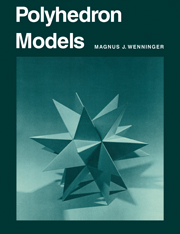Book contents
- Frontmatter
- Dedication
- Contents
- Preface to 1978 reprint
- Preface
- Foreword
- Introduction: uniform polyhedra
- Mathematical classification
- Section I The Convex Uniform Polyhedra: The Platonic and Archimedean Solids
- Section II Some Stellations and Compounds
- Section III Non-convex Uniform Polyhedra
- Commentary
- General instructions for making models of non-convex polyhedra
- Non-convex polyhedra (67–109)
- Commentary on non-convex snub polyhedra
- Non-convex snub polyhedra (110–119)
- A final comment
- Epilogue
- References
- List of models
A final comment
from Section III - Non-convex Uniform Polyhedra
Published online by Cambridge University Press: 05 August 2015
- Frontmatter
- Dedication
- Contents
- Preface to 1978 reprint
- Preface
- Foreword
- Introduction: uniform polyhedra
- Mathematical classification
- Section I The Convex Uniform Polyhedra: The Platonic and Archimedean Solids
- Section II Some Stellations and Compounds
- Section III Non-convex Uniform Polyhedra
- Commentary
- General instructions for making models of non-convex polyhedra
- Non-convex polyhedra (67–109)
- Commentary on non-convex snub polyhedra
- Non-convex snub polyhedra (110–119)
- A final comment
- Epilogue
- References
- List of models
Summary
Even if you have now made only a few of the non-convex uniform polyhedra, you can see from the models what properties belong to the set as a whole. The most interesting fact is that all of them are derived from Schwarz triangles—except one, model 119. It is exceptional in another way. It is the only known polyhedron that has more than six polygons surrounding each vertex, four squares alternating with two triangles and two pentagrams. All the squares are on planes through the solid's centre of symmetry. It is classified as a snub polyhedron because here the squares may be regarded as snub faces instead of the usual triangles as in other cases. The existence of this polyhedron indicates that spherical polygons as well as spherical triangles may give rise to other uniform polyhedra. However it is a complex task to investigate the possibilities. It still remains to be done.
You may be wondering why the stellation process was treated so thoroughly in Section n. This was done, first of all, because in some ways it is breaking new ground. Secondly, it is intrinsically a simple process, although it may indeed lead to polyhedral forms almost too numerous to detail. With enough perseverance you can discover any number of these forms by yourself. Lastly, it should help you to understand another kind of stellation, namely edge stellation. Edge stellation is that in which the edges of a polyhedron are produced to generate the edges of a new polyhedron. A simple example is found in the dodecahedron, whose edges if produced generate the edges of the small stellated dodecahedron. Stick models can show this very plainly. Many uniform polyhedra are edge stellations of other uniform polyhedra. But it must be left for you to pursue this matter further on your own.
- Type
- Chapter
- Information
- Polyhedron Models , pp. 204Publisher: Cambridge University PressPrint publication year: 1971



